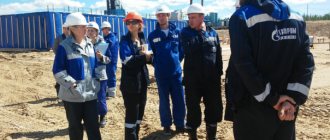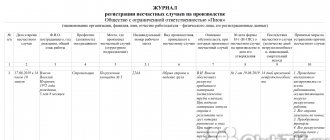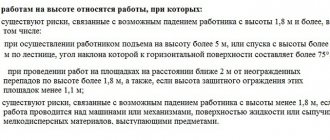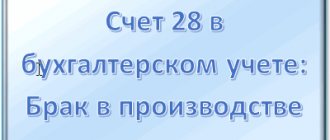What is meant by an accident at work?
An industrial accident is an unpleasant event that happened to a person during the performance of his work duties, leading to deterioration of health and entailing consequences provided for by law.
The consequences of such an incident can be: transfer to another job, complete loss of ability to work or professional skills, as well as death.
conclusions
We will draw conclusions on the topic studied and highlight the main points:
- Accidents can be of different types.
- The Labor Code of the Russian Federation defines not only the concept, but also specific types of production-type NS.
- The main qualifying feature of industrial accidents, according to severity: mild, severe and fatal. Depending on them, the employer is held liable.
- Only medical personnel can classify an incident by severity. institution treating the victim. The conclusion is issued at the request of the employer within three days after its receipt.
- There is a liver injury of a severe type, approved at the legislative level.
Types of accidents
Before considering the classifications of industrial accidents, it is necessary to understand their types:
- Industrial incidents. Cases that occurred with workers, pupils, students performing work on the territory of the enterprise on the instructions of the manager. This also applies to those who travel to or from the place of work using company transport, when performing work on holidays and weekends by order of management. Also as a result of poisoning, heat stroke, frostbite that occurred at work.
- Work-related misfortunes. Incidents that occurred while performing public or government duties, going to work on your personal or public transport, while participating in training and competitions, loss of ability to work in connection with blood donation functions, during business trips.
- Household. This category includes incidents that occurred off-site, outside of work hours, and not while commuting to or from work.
What is considered an accident, what accidents are considered production-related?
To determine the categories of industrial accidents , you should better understand this phenomenon and understand what types of cases there are. As a general rule, an accident is an incident that resulted in harm to the health or life of a person.
They can be divided into 2 groups:
- Domestic episodes are cases where the injury occurred at home, on vacation, or under other circumstances not related to work.
- Work situations are cases where an injury occurs during working hours.
The second group, in turn, is divided into 2 subgroups:
- Industrial-related tragedies. These are considered to be incidents that occurred during working hours or during breaks. Working time includes the journey to work and home (subject to certain circumstances that will be discussed below).
- Incidents not related to production. The decision whether to consider an incident to be industrial or not is made by the investigation commission. This takes into account such factors as the time of the incident, the status of the victim and other circumstances (the level of health of the victim, the absence of signs of a crime in the actions of the victim when receiving injury, etc.).
Accident severity levels
It is impossible to determine the severity of the accident without conducting a certain investigation.
During it, an analysis of the circumstances of the incident is carried out, but the main aspect is the analysis of the factors that provoked the accident. Classification of the causes of an incident at an enterprise is a necessary basis for determining further investigation. There are several nuances to the organizational plan that triggered the incident that caused injury in the workplace, including:
- improper organization of work;
- uncontrollability of the labor process;
- disorder in the workplace;
- poor quality worker training;
- failure to provide safety training in a timely manner;
- lack of special clothing and protective equipment;
- untimely repair of equipment;
- violation of labor discipline.
Each of the above reasons can become a catalyst that provokes an accident.
Classification of injuries by type
The causes of industrial injuries are divided into objective and accidental. The latter include isolated accidents on the territory of the enterprise that are not related to work or the specifics of production. For example, a person twisted his leg out of the blue or stared at welding and “caught bunnies” and suffered eye damage.
Objective reasons include:
- technical;
- sanitary and hygienic;
- organizational;
- physiological – personal.
The largest number of work-related injuries occur due to technical reasons. This is a malfunction of equipment and tools, poor insulation of power cables.
The workplace must have protective screens and shields that protect against the ingress of chips, scale and other dangerous objects.
Welding stations are fenced around the perimeter to protect the eyes of people passing by. The worker himself must wear a special suit and protective equipment in the form of glasses, boots, and gloves.
Sanitary and hygiene reasons
Reasons that are sanitary and hygienic factors that negatively affect health:
- bad light;
- drafts;
- low and high temperatures;
- air pollution;
- evaporation of harmful substances;
- poor ventilation;
- vibration;
- noise:
- lack of sanitary facilities.
In a poorly lit workshop, you may not notice the dangerous movement of individual pieces of equipment, a crane carrying a load, or an approaching electric vehicle. Drafts and cold provoke colds, inflammation, and the development of occupational diseases. The lack of household premises violates the standards of personal hygiene of people.
With poor ventilation, harmful substances accumulate in the air, which enter the respiratory system, affect the mucous membranes and blood, and cause occupational diseases.
Drafts, vibration and noise gradually cause irreversible processes in the human body: chronic inflammation, tremors, diseases of the musculoskeletal system.
Poor organization of work areas
Organizational reasons often lead to injuries due to poorly cleared aisles and paths and unpaved sidewalks in winter. The enterprise administration must take care of:
- correct placement of equipment;
- compliance with transportation standards;
- training in safe working methods;
- fencing hazardous areas;
- creating storage areas;
- all employees have special clothing appropriate to their profession;
- installation of sound and light alarms on all lifting and transport mechanisms.
The organization of labor begins outside the territory of the enterprise. What sidewalks do people use to get to the enterprise? The condition of the tracks at the plant itself. If there are holes and debris everywhere, then the likelihood of foot injury increases sharply.
Violation of transportation rules, improper slinging and stacking of cargo leads to its fall. Clogged aisles and driveways threaten to bring down everything that has accumulated in them onto people passing and driving by.
High-risk areas should be fenced and accessible only to people working there. For example, the crane cabin must be closed. The key is kept by the workshop mechanic and is given only to the crane operator who starts her shift. Similarly, chemical equipment, electrical devices and vibration stands are installed in separate rooms.
The availability of regularly issued protective clothing and the use of protective equipment are important factors in reducing occupational injuries.
Regular training of workers in safe work practices should not be neglected. In addition to information, constant verification of this knowledge is necessary. Each employee should know the scope of their responsibilities and not try to do someone else’s work. The machine operator should not independently remove and install large parts on the machine if he does not have a sling operator’s license. Likewise, the crane operator listens to commands and works only with persons who have passed a special exam and have a document.
https://youtu.be/kRl3kG_JZAM
With the noise of the equipment, it is difficult to hear approaching vehicles. Loads moving at height are especially dangerous. Therefore, all cranes, machines, electric trolleys must be equipped with signals that are sharply different in nature from the hum of machine tools, welding installations and other units.
Sanitary
At the beginning of the shift, the worker must change into overalls in normal conditions, where there are no drafts and it is warm. After your shift, wash yourself and remove any dirt that has ingrained your skin and contains harmful substances. During the shift, depending on the profession and working conditions, rest breaks are taken. The worker should be able to spend 10 to 15 minutes in comfortable conditions.
If the enterprise does not have a canteen, rooms for meals must be equipped. In addition to the table and chairs, they are equipped with equipment for heating food, a boiler or an electric kettle with boiling water.
Psychophysical
Physiological causes of injuries are called personal. They depend on the state and mood of the person. For example:
- accumulation of fatigue;
- bad feeling;
- nervous overload;
- stressful state;
- monotony of work.
When assigning a job, the physical characteristics of the body and anthropometric data should also be taken into account. For example, in schools for training machine operators, the height and gender of the graduate were always taken into account during the distribution. The tallest and strongest guys were placed on large machines. The girls received turning machines DIP 100 and small single-column planing and drilling units. On them, the weight of the workpiece does not exceed 10 kg, the tool 2 kg.
The master should not allow a person in poor health to perform his duties. His inattention will lead to industrial injuries. The patient should be referred to a doctor.
Special attitude towards persons under the influence of alcohol. They should be immediately suspended from work and an act of violating safety regulations and being drunk at work should be drawn up. This is as serious an offense as driving while intoxicated.
Actions of a manager in case of injury at the enterprise
If an accident occurs, the classification of which is presented above, the employer must:
- Provide first aid to the victims, if necessary, take them to a medical facility.
- Do everything possible to prevent an accident and prevent injury to other workers.
- Record the situation, take photos or videos.
- Report the incident to special authorities within 24 hours.
Injury rate at the enterprise
To classify and record an industrial accident, the injury rate must be applied:
- Frequency factor. Allows you to determine the number of injuries over a certain period of time at a specific enterprise, expressed as a percentage.
- Gravity coefficient. Determines the relationship between the number of days of incapacity for work and the number of work-related injuries.
- Disability rate. Determines the value obtained by multiplying the frequency coefficient by the gravity coefficient. This indicator allows you to qualitatively assess the consequences of an emergency at work.
Severe work injuries
The injuries included in this category come in 2 degrees. The first category is considered if there is an immediate threat to human life.
The condition is characterized by:
- presence of suffocation, shock, bleeding or coma;
- due to an accident, there is a malfunction in the functioning of various body systems;
- dynastic events indicate that there are serious violations of varying degrees;
- internal organs were injured, radiation injuries occurred, there was a threat of miscarriage, and burns were received.
If the accident results in grade 2 work-related injuries, there is no immediate threat to life. However, the resulting injury can cause serious consequences.
Video
https://youtu.be/vPS-pu41hRw
The condition of the second degree of severity has the following characteristics:
- as a result of the incident, there is an exacerbation of chronic diseases that the person already had before;
- due to the injuries received, there was injury to the face, impairment or complete loss of speech, hearing or vision, mental disorder or loss of an organ;
- there is a long-term disability, which may lead to disability or the need to change the place of work.
Features of accident investigation
During the investigation of an accident, a labor safety inspector must be involved.
If the incident occurred as a result of an accident, then the investigation must be accompanied by materials collected by a representative of the traffic police. Also, a commission, which is specially created to classify an accident and identify those responsible, must conduct a survey:
- the victim, if possible, in other cases a special act is created;
- eyewitnesses of the accident;
- persons who allowed the emergency to occur;
- persons who committed safety violations;
- the manager of the enterprise where the incident occurred.
The victim must explain in writing why the accident occurred. If he cannot write independently or he refuses to give any explanations, then a special act is drawn up, which will make it possible to determine that all actions concerning the victim were carried out correctly and in compliance with all norms and standards.
Documentation for conducting an accident investigation
In order to correctly classify and investigate an accident, it is necessary to prepare a package of documents:
- an order to create the appropriate commission with a list of all its representatives;
- diagram of the scene of the incident;
- photo and video materials;
- accident scene inspection report;
- workplace certification card;
- explanatory statements of victims or drawn up acts;
- technical calculations and research protocols;
- conclusion of the experts who assessed the accident;
- medical report on the condition of the victim;
- card for issuing protective equipment and protective clothing;
- extracts from the safety magazine.
Members of the commission may request additional documents if the standard package of documents did not allow them to conduct a high-quality study and render a verdict.
The persons who must be held accountable for the accident must be identified. Classification by severity makes it possible to determine whether the victim will be able to continue working in the future or whether he needs to be assigned recourse - unemployment benefits resulting from an industrial accident.
Procedure for organizing an inspection: special investigation
From a legislative point of view, determining the category of an incident is important for the procedure for studying the circumstances that gave rise to the accident and searching for those responsible. If any emergency situation arises, an inspection must be organized at the enterprise, and in 3 cases a special investigation is organized:
- The outcome is severe (any case described in the table).
- The outcome is fatal.
- The case is a group one, regardless of the number of workers, and also regardless of whether they received minor or severe injuries.
For example, if a container with a heavy load falls and one worker breaks a finger and another breaks 2 lumbar vertebrae, the case will be examined during a special investigation, since 2 people were injured as a result. If the incident resulted in a mild electric shock and the employee’s condition is satisfactory, it is sufficient to conduct an internal inspection.
Composition of the commission
The commission conducting the official investigation should include the following persons:
- state labor inspector;
- other representatives of the inspection;
- policyholder;
- employer;
- trade union or other representative body;
- higher executive body;
- other specialists.
The composition of the commission and the procedure for its work are prescribed in a separate order of the head of the enterprise.
Investigation procedure: list of documents
The review must begin immediately, since the decision is made within 10 calendar days. The investigation is carried out through oral questioning of witnesses, written provision of explanatory statements, analysis of photographic materials, audio and video recordings, as well as studying the following documents:
- plans and diagrams of the place where the incident occurred;
- an extract from the journal and other documents confirming the fact that the victim/dead person underwent TB training;
- medical reports with diagnosis, severity of the case;
- decision of the expert commission establishing the cause of the incident (if necessary);
- extracts from the employer’s internal acts in the field of labor protection (regulations, orders, instructions, magazines, etc.).
All expenses associated with the work of the commission, requesting documents and other costs are paid directly by the employer.
Sample accident report
The conclusion is drawn up in an act in form N-1. It specifies the composition of the commission, the circumstances of the incident (date, time, participants, victims and much more). Based on the investigation, the cause of the accident is established, and instructions are given to employees to carry out training and other measures. When drawing up a document, you can rely on the completed sample presented below.
Further actions
Within 10 calendar days from the date of execution of the conclusion, the chairman of the commission must send a copy of it and other documents to the prosecutor's office. Further investigative actions are carried out by law enforcement agencies, interested parties go to court to bring the perpetrators to justice and compensate for harm to health and moral damage.
Measures to prevent accidents
Every production facility, even if it only employs a few people, must have a qualified specialist who monitors safety precautions. He must regularly instruct not only newly hired workers, but also those who have already been working for him for a long time. The occupational safety instructor keeps a log where each employee puts his signature confirming that he is familiar with safety precautions. This log may be requested by a commission representative if an accident occurs. The types and classification of incidents will help identify the culprit and prevent future injuries.
It is easier to prevent an accident than to eliminate its consequences. Therefore, prevention methods are important. If a labor safety inspector notices that an employee is violating safety precautions, for example, not wearing protective equipment, then he may not only be suspended from work, but also financially punished.
Safety instructions are regularly updated every 5 years, but can be more often if new equipment suddenly appears in production.
Training can be carried out at any time, especially if the safety officer has detected violations. It is also carried out if an employee returns from vacation or changes the subject of work.
A good way to prevent accidents at work are stands and corners on occupational safety, where all incidents are described and measures to help prevent their occurrence are indicated. Posters, pictures, and constant reminders will make the worker think about whether it is worth violating safety standards.
Compliance with all safety rules will help preserve not only the health of the employee, but also his life. The head of the enterprise and the labor safety inspector bear criminal liability if a worker is injured in their production, even if it is minor.










